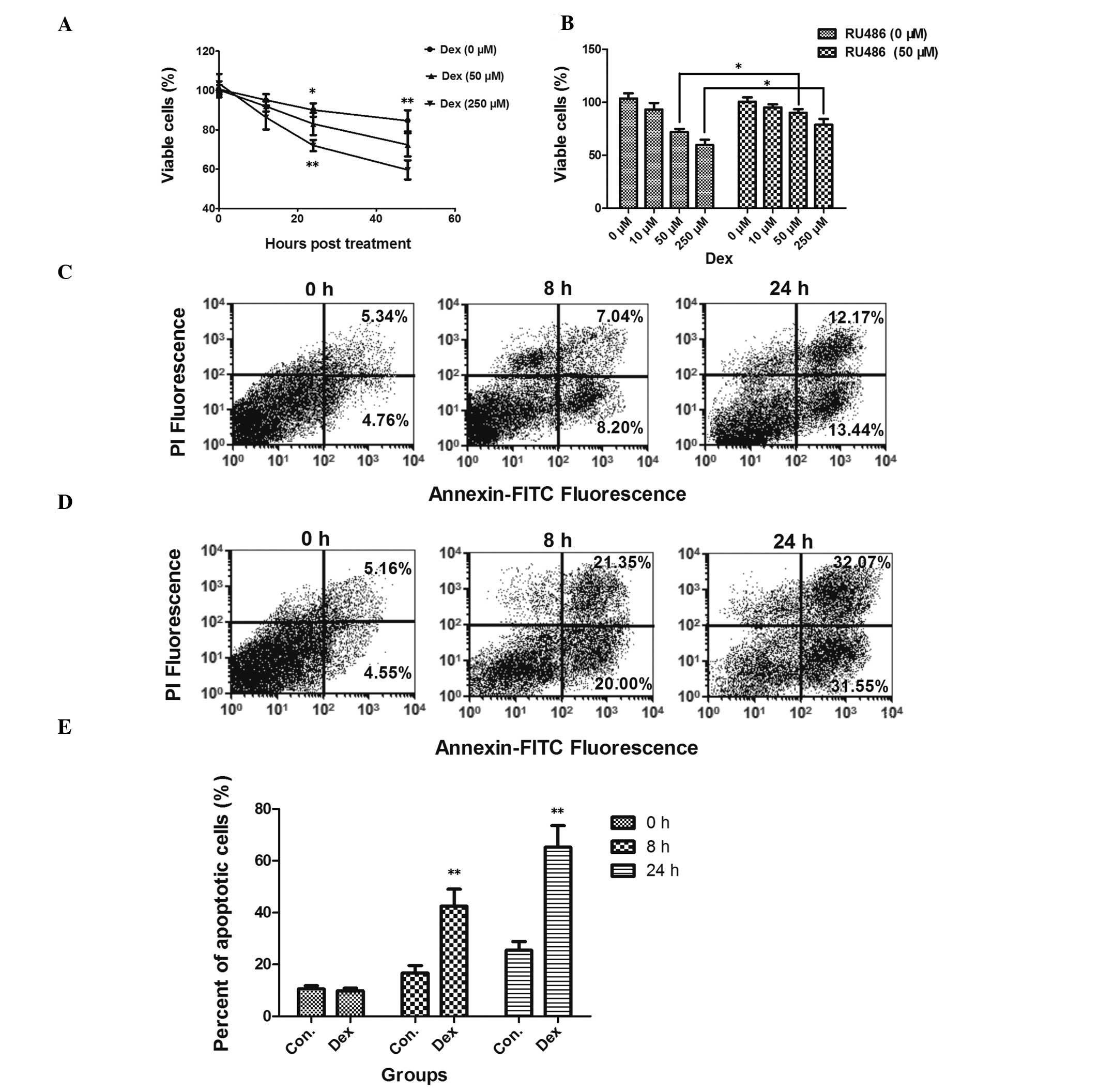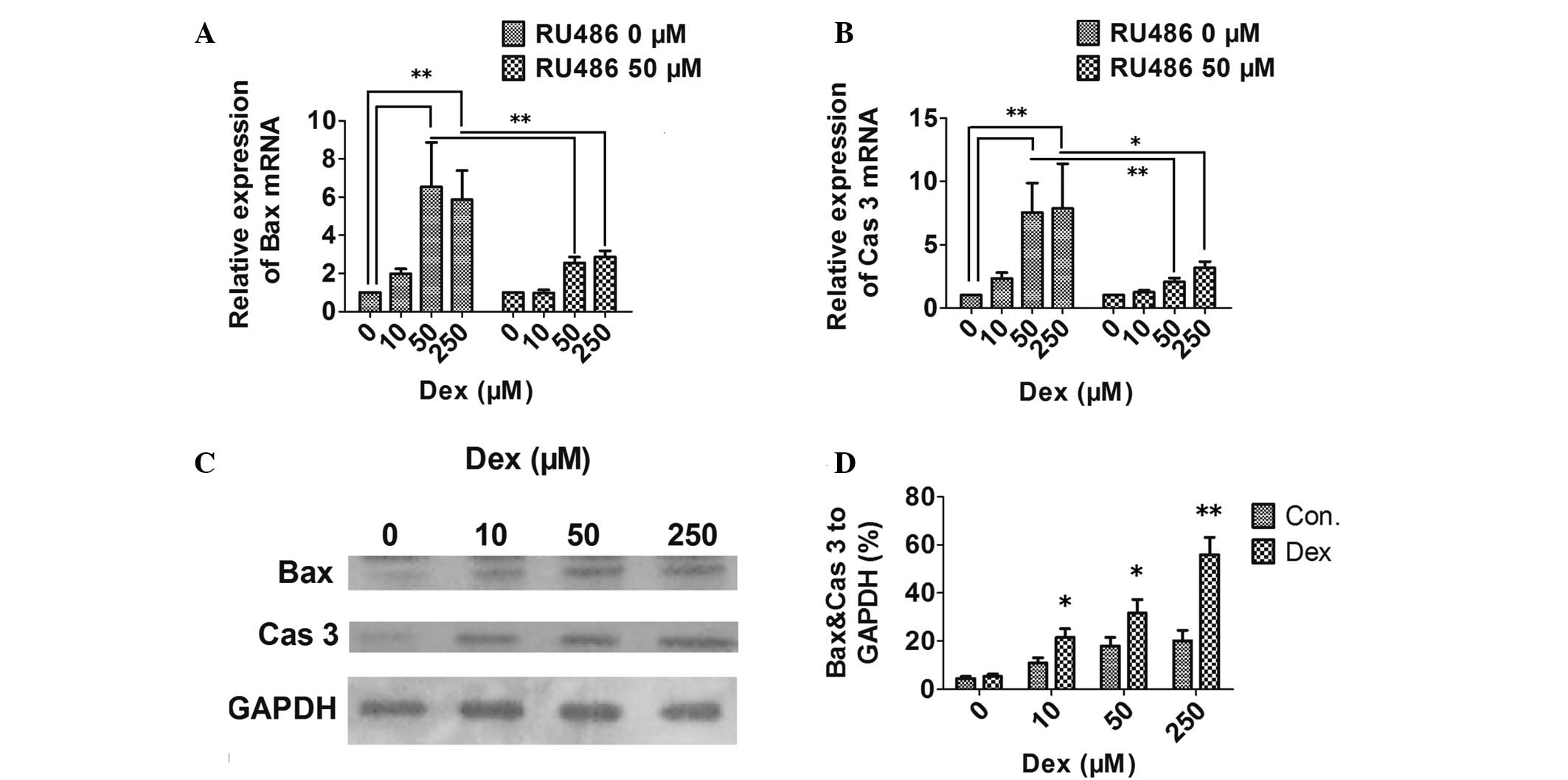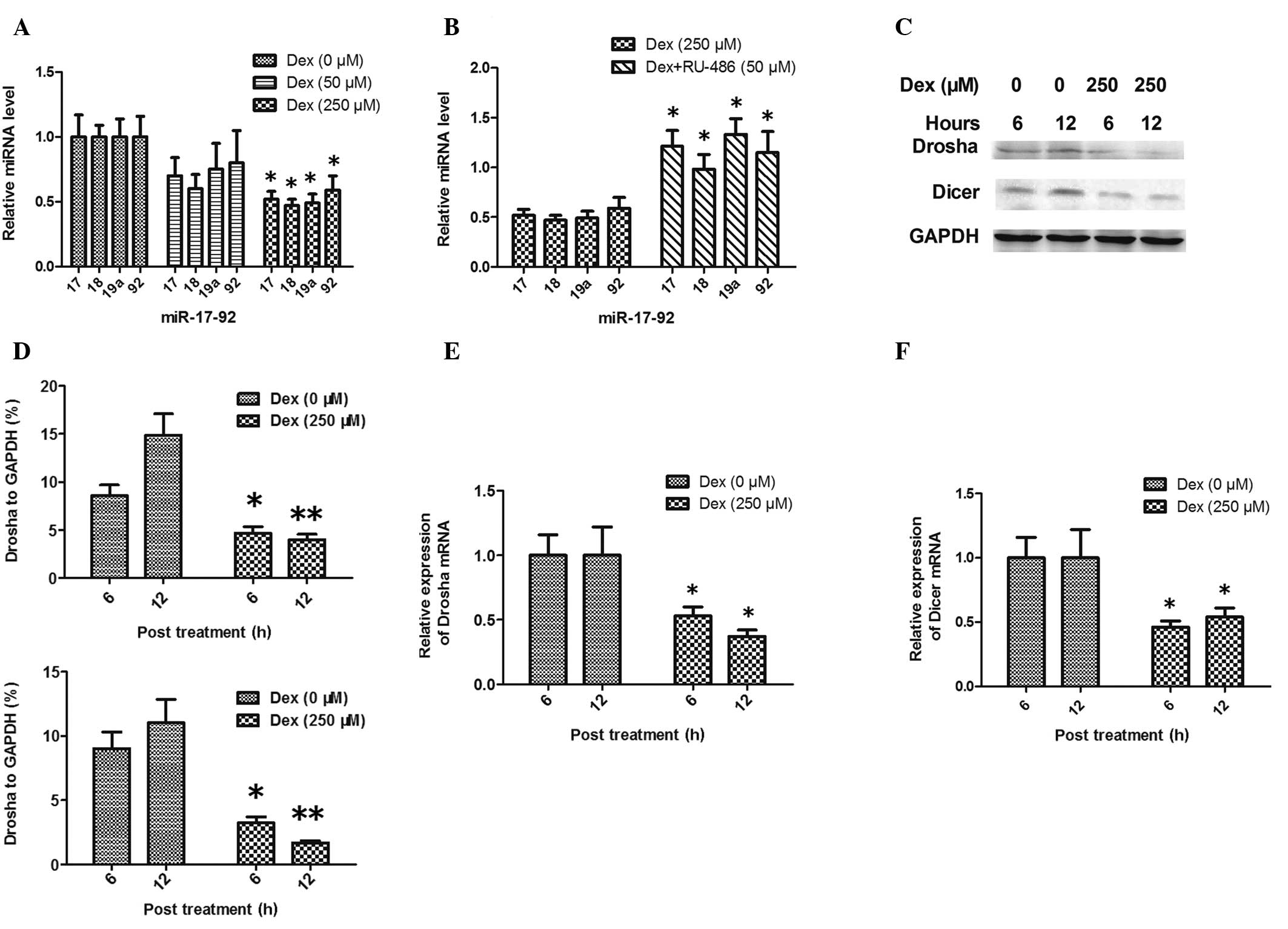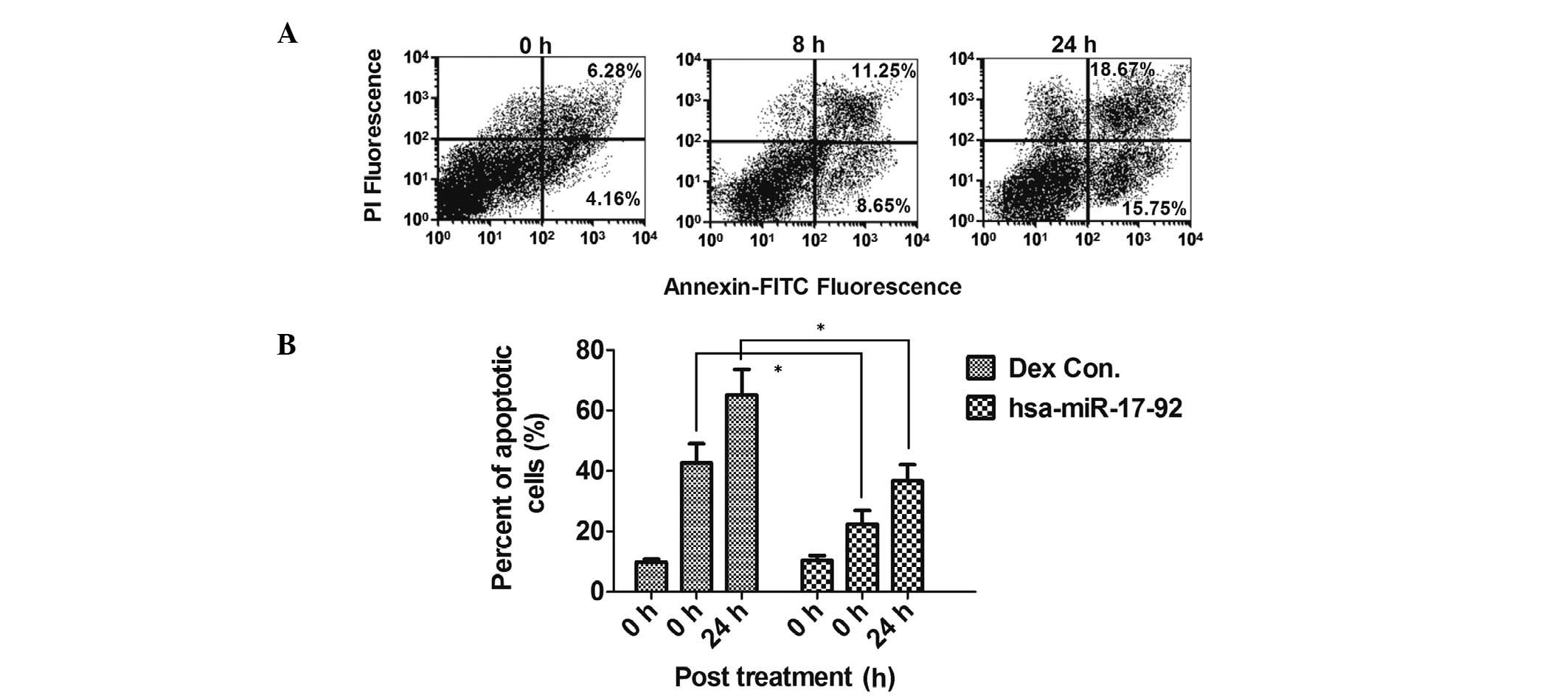Glucocorticoids induce apoptosis by inhibiting microRNA cluster miR‑17‑92 expression in chondrocytic cells
- Authors:
- Published online on: May 20, 2014 https://doi.org/10.3892/mmr.2014.2253
- Pages: 881-886
Abstract
Introduction
Glucocorticoids (GCs) are widely used for the treatment of chronic orthopedic diseases, including lumbar disc herniation, rheumatism and chronic inflammatory or autoimmune diseases. The potent anti-inflammatory and immunosuppressive effects of GCs give them the reputation of being a ‘miracle elixir’. However, prolonged treatment with GCs results in alterations in water and salt metabolism, metabolic disorders and impairment of skeletal development (1–3). Sustained administration of GCs is frequently accompanied by decreased generation of osteoblasts and osteocytes, as well as a prolonged lifespan of osteoclasts. Previous studies have indicated that apoptosis and autophagy in osteocytes may be involved in the mechanism underlying the GC-induced impairment of skeletal development (4–6). The influence of GCs on chondrocytes, which have a key role in skeletal development, has been rarely reported. Certain studies have shown that GCs have an effect on the apoptosis and differentiation of chondrocytes (7,8); however, the details of this require elucidation.
MicroRNAs (miRNAs) are a family of ~22-nucleotide, endogenous, non-coding RNAs and have been identified in organisms ranging from nematodes to humans. miRNAs are able to bind to the 3′ untranslated regions (3′-UTRs) of mRNAs and regulate gene expression by post-transcriptional gene inhibition (9,10). An increasing number of studies have revealed that miRNAs have important roles in the regulation of apoptosis. MicroRNA-708 (miR-708), -195, -206 and -155 have been demonstrated to separately induce or facilitate apoptosis in renal cancer cells, cardiomyocytes, tumor cells and macrophages (11–14). The regulation of apoptosis in chondrocytes and, in particular, its regulation by miRNAs has rarely been studied. However, of note was the finding by Abouheif et al (15) that silencing miR-34a inhibited apoptosis of chondrocytes in a rat osteoarthritis model in vitro. There is a requirement to identify miRNAs that have roles in the regulation of apoptosis in chondrocytes.
In the present study, GC-induced apoptosis was assessed in the human chondrocytic HCS-2/8 cell line and the role of the miR-17–92 cluster in this process was evaluated.
Materials and methods
Reagents and cell cultures
The GC dexamethasone (Dex, Sigma-Aldrich, St. Louis, MO, USA) was dissolved in α-Minimum Essential Medium (α-MEM) with 0.5% ethanol, and the GC antagonist RU486 (Sigma-Aldrich) was dissolved in dimethylsulfoxide (DMSO). HCS-2/8 cells were provided by the cell resource center of the Chinese Academy of Medical Sciences (Beijing, China). Unless otherwise specified, HCS-2/8 cells were inoculated in Eagle’s MEM, supplemented with 20% fetal bovine serum (FBS) and 0.2% penicillin/streptomycin at 37°C under 5% CO2.
Cell viability assay
Cell viability was assessed using the MTT assay. HCS-2/8 cells were seeded in 96-well plates and incubated at 37°C for 24 h, prior to the replacement of the medium with Eagle’s MEM containing 2% FBS. Dex (0, 50 or 250 μM) and/or RU486 (0 or 250 μM) was added to the medium and incubation was continued for up to 0, 24 or 48 h. The medium was subsequently replaced with 50 μl MTT solution and the cells were incubated at 37°C. After 2 h of incubation, the MTT solution was discarded and 150 μl DMSO was added to completely dissolve the precipitate at room temperature. The optical density was then measured at 570 nm using a spectrophotometer.
Apoptosis assays
Apoptosis was assessed using an annexin V-fluorescein isothiocyanate (FITC) apoptosis detection kit (Sigma-Aldrich). Briefly, 1–5×105 HCS-2/8 cells were resuspended in 0.5 ml binding buffer and incubated with annexin V-FITC and propidium iodide for 10 min in the dark at room temperature. A FACScan flow cytometer (BD Biosciences, Franklin Lanes, NJ, USA) equipped with an FITC signal detector FL1 (excitation 488 nm, green) and a phycoerythrin emission signal detector FL3 (excitation 585 nm, red) was used to quantify cellular apoptosis. The results were calculated using the CellQuest™ Pro software (BD Biosciences) and expressed as the percentage of apoptotic cells among the total cells.
RNA isolation, quantitative polymerase chain reaction (qPCR) and RNase protection assay
Total cellular RNA from ~105 cells was prepared using TRIzol® reagent (Invitrogen Life Technologies, Carlsbad, CA, USA). miRNAs were isolated using the mirVANA™ miRNA isolation kit (Ambion, Austin, TX, USA). qPCR was performed with the Takara One-Step RT-PCR kit (Takara Bio, Inc., Dalian, China). For quantitative analysis of the mRNA expression of BCL2-associated X protein (Bax), caspase 3, Drosha and Dicer, the resulting cDNAs were amplified using primer/probe sets specific for the genes of interest on a Lightcycler 480 II (Roche, Mannheim, Germany). Relative quantification was performed using the ΔΔCt method with GAPDH as the reference gene. The primer sequences used in the present study are shown in Table I.
Western blot analysis
Whole cell lysates were obtained by suspending ~105 cells in cell lysis reagent (Promega Corp., Madison, WI, USA), and Complete Mini Protease Inhibitor Cocktail (Roche). Following protein concentration determination using Bradford Reagent (Bio-Rad, Hercules, CA, USA), equal amounts of protein and sample buffer were separated using 4–20% gradient SDS-PAGE, transferred onto a polyvinylidene fluoride membrane and blocked in Tris-buffered saline containing skimmed milk (5%). The following primary antibodies were used: Caspase 3 rabbit polyclonal antibody, 1:500 (Sigma-Aldrich); Dicer rabbit polyclonal antibody, 1:500 (Santa Cruz Biotechnology, Inc., Santa Cruz, CA, USA); Drosha rabbit polyclonal antibody, 1:500 (Santa Cruz Biotechnology, Inc.); and GAPDH rabbit polyclonal antibody, 1:1,000 (Sigma-Aldrich). All immunoblots are representative of at least three independent experiments.
Overexpression of miR-17-92
Overexpression of miR-17-92 was performed using miRNA mimics (Qiagen, Valencia, CA, USA) for individual miRNAs: miR-17, miR-18, miR-19a and miR-92. For the assessment of the association between miR-17-92 and apoptosis, a mixture of all four miRNA mimics (200 nM each) or 1,200 nM nontargeting control was transfected into HCS-2/8 cells with Lipofectamine 2000. Six hours post-transfection, cells were incubated with Dex for 8 or 24 h and assayed for apoptosis.
Statistical analysis
Statistical analyses were performed using SPSS 16.0 software (SPSS, Inc., Chicago, IL, USA). The differences in cell viability, apoptosis, expression of Cas3, Bax, miRNAs, Drosha or Dicer between the two groups were analyzed by Student’s t test. P<0.05 was to indicate a statistically significant difference.
Results
Dex reduces HCS-2/8 chondrocyte cell viability via the induction of apoptosis
To assess the effect of Dex on the viability of HCS-2/8 chondrocytic cells, the MTT assay was conducted. Fig. 1A shows that Dex was able to reduce the cell viability following 24 h (82.51±5.60%, P<0.05 versus the control at 50 μM; 72.00±2.85%, P<0.01 versus the control at 250 μM) or 48 h (72.30±5.91%, P<0.01 versus the control at 50 μM; 59.63±4.90%, P<0.01 versus the control at 250 μM) of incubation. The GC antagonist RU486 (50 μM) was utilized to re-confirm the effect of Dex on cell viability. HCS-2/8 cells were pre-treated with RU486 prior to incubation with Dex. It was shown that RU486 reversed the decrease in cell viability induced by Dex after 48 h of incubation (Fig. 1B).
GC-induced apoptosis has been reported in various cell models (16–19), including chondrocyte cells (20,21); therefore, it was assessed whether the decreased cell viability following Dex treatment was due to apoptosis. Fig. 1C–E shows that apoptosis was significantly increased following incubation with Dex (250 μM) for 8 or 24 h (P<0.01). To further confirm that apoptosis was induced by Dex, the mRNA and protein expression levels of the proapoptotic Bax and the apoptosis executioner caspase 3 were also assayed by qPCR and western blot analysis. mRNA (Fig. 2A and B) and protein levels (Fig. 2C and D) of Bax and caspase 3 in HCS-2/8 cells were significantly higher following incubation with Dex. In addition, the GC antagonist RU486 was able to inhibit the Dex-induced expression of apoptosis-associated molecules (Fig. 2A and B).
Inhibition of miR-17-92 cluster expression and miRNA processing enzymes during GC-induced apoptosis in HCS-2/8 chondrocytic cells
To date, the knowledge on the mechanism underlying Dex-induced apoptosis in chondrocyte cells is limited. An increasing number of studies have shown that miRNAs are involved in apoptosis (22,23); in particular, the GC-mediated inhibition of the expression of the miR-17-92 cluster has been shown to contribute to the initiation of apoptosis in a T-cell lymphoma cell line (24). To evaluate the possible role of the miR-17-92 cluster in Dex-induced apoptosis in HCS-2/8 chondrocytic cells, qPCR was used to determine the expression of miR-17, -18, -19a and -92. Fig. 3A and B shows that these four miRNAs were downregulated in HCS-2/8 cells following incubation with 250 μM Dex for 12 h (P<0.05 versus the control); however, this was not observed in the 50 μM Dex treatment group (P>0.05 versus the control). To further investigate the downregulation of the mature miR-17-92 cluster by GCs, the expression of the key miRNA processing enzymes Drosha and Dicer was assessed during GC-induced apoptosis of HCS-2/8 cells. Western blot analysis and qPCR demonstrated that the expression of Drosha and Dicer was inhibited by Dex at the mRNA and protein levels (Fig. 3C–F).
Overexpression of the miR-17-92 cluster inhibits GC-induced apoptosis
To reconfirm the potential anti-apoptotic role of the miR-17-92 cluster, which was downregulated during GC-induced apoptosis in HCS-2/8 cells, the miR-17-92 cluster was overexpressed in HCS-2/8 cells via transfection with the hsa-miR-17-92 miRNA mimics miR-17, miR-18, miR-19a and miR-92. Overexpression of the hsa-miR-17-92 cluster in the HCS-2/8 cells significantly reduced the ability of Dex to induce apoptosis (Fig. 4A and B; Fig. 1C and E). This reduced sensitivity was not due to decreased GC receptor (GR) expression in response to hsa-miR-17-92 overexpression (data not shown). These data suggest that the specific inhibition of the miR-17-92 cluster contributes to the GC-induced apoptosis of chondrocyte cells in vitro.
Discussion
Chondrocytes have a key role in skeletal development, and studies have shown that GCs exert an effect on the apoptosis and differentiation of chondrocytes (7,8). The present study demonstrated that Dex induced apoptosis in HCS-2/8 cells and reduced cell viability. Dex also inhibited the expression of the proapoptotic protein Bax and the apoptosis executioner caspase 3. The GC antagonist RU486 was able to inhibit the decrease in cell viability and the high expression of Bax and caspase 3 mRNA induced by Dex. Therefore, the apoptosis and decrease in cell viability induced by Dex is GR-dependent.
The mechanism underlying GC-induced apoptosis in chondrocytes has yet to be fully elucidated; however, the mechanism of GC-driven apoptosis in lymphoid cells has been investigated to a greater extent. The participation of effector caspases, including caspase 3, the prosurvival role of B-cell lymphoma 2 (25) and the direct interactions between the GR and the transcription factors nuclear factor of κ light polypeptide gene enhancer in B cells and activator protein 1 have been documented (26). Additional signaling molecules, including related adhesion focal tyrosine kinase, signal transducer and activator of transcription 3, calcium and interleukin 6 have also been identified to participate in the GC-induced apoptotic signaling cascade (27–30). However, the knowledge of these signaling molecules and signaling events is currently not sufficient to establish a logical chronology. Therefore, further studies are required to define the signaling pathways involved in GC-induced apoptosis.
Noncoding miRNAs have emerged as important gene expression regulatory elements (31,32). Transcribed by RNA polymerase II, miRNA precursors undergo extensive post-transcriptional processing by the nuclear RNase III enzyme Drosha and the RNase III enzyme Dicer in the cytoplasm. The biologically active, mature, single-stranded miRNA is then incorporated into the miRNA-induced silencing complex to affect gene expression through the inhibitory engagement of complementary ‘seed sequences’ within the 3′-UTRs of target mRNAs, resulting in translational inhibition (33,34). Through the modulation of gene expression, miRNAs are key effectors of fundamental biological processes, including development, differentiation and apoptosis (35). It has been demonstrated that the miR-17-92 cluster possesses a conserved anti-apoptotic function in lymphocytes in vitro and in vivo (24,36–38) by inhibiting the expression of the proapoptotic Bcl-2-interacting mediator of cell death 2 as well as that of the phosphatase and tensin homolog (38). It remains to be elucidated whether the miR-17-92 cluster is involved in the apoptosis of chondrocytes following treatment with GCs.
In the present study, HCS-2/8 cells were selected as an in vitro model of human chondrocytes to evaluate the apoptosis induced by Dex, and the possible role of the miR-17-92 cluster in the regulation of apoptosis was investigated. It was demonstrated that Dex was able to inhibit the expression of the miR-17-92 cluster, and this was accompanied by a reduced expression of the miRNA-processing enzymes Drosha and Dicer. The modulation of miR-17-92 expression altered GC-induced apoptosis: Overexpression of miR-17-92 partially inhibited apoptosis in HCS-2/8 cells.
In conclusion, the present study demonstrated that Dex was able to induce apoptosis in HCS-2/8 chondrocytic cells, and that the expression of the miR-17-92 cluster was inhibited during Dex-induced apoptosis. It was indicated that inhibition of the expression of the miR-17-92 cluster contributed to the Dex-induced apoptosis in chondrocytes. The results suggest that microRNAs have an important role in glucocorticoid-induced impairment to chondrocytes.
Acknowledgements
The present study was supported by grants from the Second Affiliated Hospital of Inner Mongolia Medical University (Hohhot, China).
References
|
Canalis E and Delany AM: Mechanisms of glucocorticoid action in bone. Ann NY Acad Sci. 966:73–81. 2002. View Article : Google Scholar | |
|
Altman A, Hochberg Z and Silbermann M: Interactions between growth hormone and dexamethasone in skeletal growth and bone structure of the young mouse. Calcif Tissue Int. 51:298–304. 1992. View Article : Google Scholar : PubMed/NCBI | |
|
Allen DB: Growth suppression by glucocorticoid therapy. Endocrinol Metab Clin North Am. 25:699–717. 1996. View Article : Google Scholar : PubMed/NCBI | |
|
Weinstein RS, Nicholas RW and Manolagas SC: Apoptosis of osteocytes in glucocorticoid-induced osteonecrosis of the hip. J Clin Endocrinol Metab. 85:2907–2912. 2000.PubMed/NCBI | |
|
Xia X, Kar R, Gluhak-Heinrich J, et al: Glucocorticoid-induced autophagy in osteocytes. J Bone Miner Res. 25:2479–2488. 2010. View Article : Google Scholar : PubMed/NCBI | |
|
Jia J, Yao W, Guan M, et al: Glucocorticoid dose determines osteocyte cell fate. FASEB J. 25:3366–3376. 2011. View Article : Google Scholar : PubMed/NCBI | |
|
Owen HC, Roberts SJ, Ahmed SF and Farquharson C: Dexamethasone-induced expression of the glucocorticoid response gene lipocalin 2 in chondrocytes. Am J Physiol Endocrinol Metab. 294:E1023–E1034. 2008. View Article : Google Scholar : PubMed/NCBI | |
|
Mushtaq T, Farquharson C, Seawright E and Ahmed SF: Glucocorticoid effects on chondrogenesis, differentiation and apoptosis in the murine ATDC5 chondrocyte cell line. J Endocrinol. 175:705–713. 2002. View Article : Google Scholar : PubMed/NCBI | |
|
Bartel DP: MicroRNAs: target recognition and regulatory functions. Cell. 136:215–233. 2009. View Article : Google Scholar : PubMed/NCBI | |
|
Shukla GC, Singh J and Barik S: MicroRNAs: Processing, maturation, target recognition and regulatory functions. Mol Cell Pharmacol. 3:83–92. 2011.PubMed/NCBI | |
|
Saini S, Yamamura S, Majid S, et al: MicroRNA-708 induces apoptosis and suppresses tumorigenicity in renal cancer cells. Cancer Res. 1:6208–6219. 2011. View Article : Google Scholar : PubMed/NCBI | |
|
Zhu H, Yang Y, Wang Y, et al: MicroRNA-195 promotes palmitate-induced apoptosis in cardiomyocytes by down-regulating Sirt1. Cardiovasc Res. 92:75–84. 2011. View Article : Google Scholar : PubMed/NCBI | |
|
Song G, Zhang Y and Wang L: MicroRNA-206 targets notch3, activates apoptosis, and inhibits tumor cell migration and focus formation. J Biol Chem. 284:31921–3127. 2009. View Article : Google Scholar : PubMed/NCBI | |
|
Ghorpade DS, Leyland R, Kurowska-Stolarska M, Patil SA and Balaji KN: MicroRNA-155 is required for Mycobacterium bovis BCG-mediated apoptosis of macrophages. Mol Cell Biol. 32:2239–2253. 2012.PubMed/NCBI | |
|
Abouheif MM, Nakasa T, Shibuya H, et al: Silencing microRNA-34a inhibits chondrocyte apoptosis in a rat osteoarthritis model in vitro. Rheumatology (Oxford). 49:2054–2060. 2010. View Article : Google Scholar : PubMed/NCBI | |
|
Dowd DR, MacDonald PN, Komm BS, et al: Evidence for early induction of calmodulin gene expression in lymphocytes undergoing glucocorticoid-mediated apoptosis. J Biol Chem. 266:18423–18426. 1991.PubMed/NCBI | |
|
Carey KT, Tan KH, Ng J, et al: Nfil3 is a glucocorticoid-regulated gene required for glucocorticoid-induced apoptosis in male murine T cells. Endocrinology. 154:1540–1552. 2013. View Article : Google Scholar : PubMed/NCBI | |
|
Talabér G, Boldizsár F, Bartis D, et al: Mitochondrial translocation of the glucocorticoid receptor in double-positive thymocytes correlates with their sensitivity to glucocorticoid-induced apoptosis. Int Immunol. 21:1269–1276. 2009. | |
|
Jewell CM, Scoltock AB, Hamel BL, Yudt MR and Cidlowski JA: Complex human glucocorticoid receptor dim mutations define glucocorticoid induced apoptotic resistance in bone cells. Mol Endocrinol. 26:244–256. 2012. View Article : Google Scholar | |
|
Zaman F, Chrysis D, Huntjens K, Fadeel B and Sävendahl L: Ablation of the pro-apoptotic protein Bax protects mice from glucocorticoid-induced bone growth impairment. PLoS One. 7:e331682012. View Article : Google Scholar : PubMed/NCBI | |
|
Chrysis D, Zaman F, Chagin AS, Takigawa M and Sävendahl L: Dexamethasone induces apoptosis in proliferative chondrocytes through activation of caspases and suppression of the Akt-phosphatidylinositol 3′-kinase signaling pathway. Endocrinology. 146:1391–1397. 2005.PubMed/NCBI | |
|
Su H, Yang JR, Xu T, et al: MicroRNA-101, down-regulated in hepatocellular carcinoma, promotes apoptosis and suppresses tumorigenicity. Cancer Res. 69:1135–1142. 2009. View Article : Google Scholar : PubMed/NCBI | |
|
Carletti MZ, Fiedler SD and Christenson LK: MicroRNA 21 blocks apoptosis in mouse periovulatory granulosa cells. Biol Reprod. 83:286–295. 2010. View Article : Google Scholar : PubMed/NCBI | |
|
Molitoris JK, McColl KS and Distelhorst CW: Glucocorticoid-mediated repression of the oncogenic microRNA cluster miR-17~92 contributes to the induction of Bim and initiation of apoptosis. Mol Endocrinol. 25:409–420. 2011. View Article : Google Scholar : PubMed/NCBI | |
|
Kofler R: The molecular basis of glucocorticoid-induced apoptosis of lymphoblastic leukemia cells. Histochem Cell Biol. 114:1–7. 2000.PubMed/NCBI | |
|
Greenstein S, Ghias K, Krett NL and Rosen ST: Mechanisms of glucocorticoid-mediated apoptosis in hematological malignancies. Clin Cancer Res. 8:1681–1694. 2002.PubMed/NCBI | |
|
Chauhan D, Hideshima T, Pandey P, et al: RAFTK/PYK2-dependent and -independent apoptosis in multiple myeloma cells. Oncogene. 18:6733–6740. 1999. View Article : Google Scholar : PubMed/NCBI | |
|
Epling-Burnette PK, Liu JH, Catlett-Falcone R, et al: Inhibition of STAT3 signaling leads to apoptosis of leukemic large granular lymphocytes and decreased Mcl-1 expression. J Clin Invest. 107:351–362. 2001. View Article : Google Scholar : PubMed/NCBI | |
|
Distelhorst CW and Dubyak G: Role of calcium in glucocorticosteroid-induced apoptosis of thymocytes and lymphoma cells: resurrection of old theories by new findings. Blood. 91:731–734. 1998.PubMed/NCBI | |
|
Chauhan D, Pandey P, Ogata A, et al: Dexamethasone induces apoptosis of multiple myeloma cells in a JNK/SAP kinase independent mechanism. Oncogene. 15:837–843. 1997. View Article : Google Scholar : PubMed/NCBI | |
|
Bartel DP: MicroRNAs: Target recognition and regulatory functions. Cell. 136:215–233. 2009. View Article : Google Scholar : PubMed/NCBI | |
|
Brennecke J, Hipfner DR, Stark A, Russell RB and Cohen SM: Bantam encodes a developmentally regulated microRNA that controls cell proliferation and regulates the proapoptotic gene hid in drosophila. Cell. 113:25–36. 2003. View Article : Google Scholar : PubMed/NCBI | |
|
Kim VN: MicroRNA biogenesis: coordinated cropping and dicing. Nat Rev Mol Cell Biol. 6:376–385. 2005. View Article : Google Scholar : PubMed/NCBI | |
|
Cullen BR: Transcription and processing of human microRNA precursors. Mol Cell. 16:861–865. 2004. View Article : Google Scholar : PubMed/NCBI | |
|
Esquela-Kerscher A and Slack FJ: Oncomirs - microRNAs with a role in cancer. Nat Rev Cancer. 6:259–269. 2006. View Article : Google Scholar | |
|
He L, Thomson JM, Hemann MT, et al: A microRNA polycistron as a potential human oncogene. Nature. 435:828–833. 2005. View Article : Google Scholar : PubMed/NCBI | |
|
Xiao C, Srinivasan L, Calado DP, et al: Lymphoproliferative disease and autoimmunity in mice with increased miR-17-92 expression in lymphocytes. Nat Immunol. 9:405–414. 2008. View Article : Google Scholar : PubMed/NCBI | |
|
Smith LK, Shah RR and Cidlowski JA: Glucocorticoids modulate microRNA expression and processing during lymphocyte apoptosis. J Biol Chem. 285:36698–36708. 2010. View Article : Google Scholar : PubMed/NCBI |













